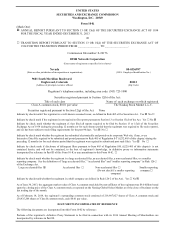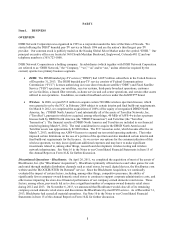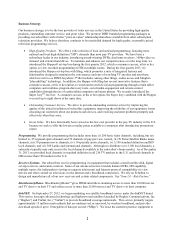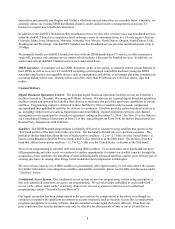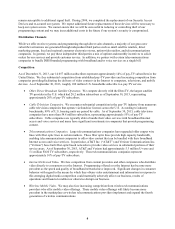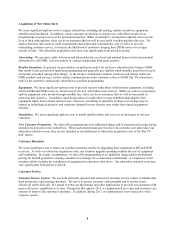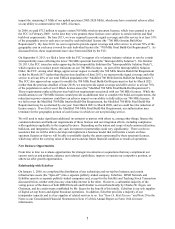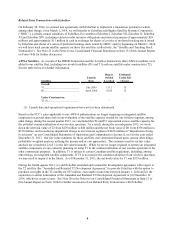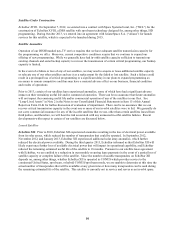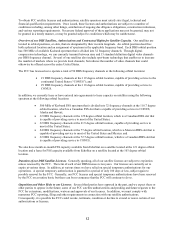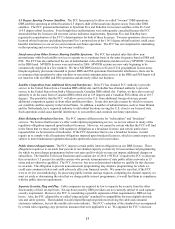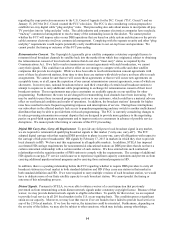Dish Network 2013 Annual Report Download - page 14
Download and view the complete annual report
Please find page 14 of the 2013 Dish Network annual report below. You can navigate through the pages in the report by either clicking on the pages listed below, or by using the keyword search tool below to find specific information within the annual report.4
4
remain susceptible to additional signal theft. During 2009, we completed the replacement of our Security Access
Devices and re-secured our system. We expect additional future replacements of these devices will be necessary to
keep our system secure. We cannot ensure that we will be successful in reducing or controlling theft of our
programming content and we may incur additional costs in the future if our system’s security is compromised.
Distribution Channels
While we offer receiver systems and programming through direct sales channels, a majority of our gross new
subscriber activations are generated through independent third parties such as small satellite retailers, direct
marketing groups, local and regional consumer electronics stores, nationwide retailers, and telecommunications
companies. In general, we pay these independent third parties a mix of upfront and monthly incentives to solicit
orders for our services and provide customer service. In addition, we partner with certain telecommunications
companies to bundle DISH branded programming with broadband and/or voice services on a single bill.
Competition
As of December 31, 2013, our 14.057 million subscribers represent approximately 14% of pay-TV subscribers in the
United States. We face substantial competition from established pay-TV providers and increasing competition from
companies providing/facilitating the delivery of video content via the Internet to computers, televisions, and mobile
devices. As of September 30, 2013, roughly 100 million U.S. households subscribe to a pay-TV service.
x Other Direct Broadcast Satellite Operators. We compete directly with the DirecTV, the largest satellite
TV provider in the U.S. which had 20.2 million subscribers as of September 30, 2013, representing
approximately 20% of pay-TV subscribers.
x Cable Television Companies. We encounter substantial competition in the pay-TV industry from numerous
cable television companies that operate via franchise licenses across the U.S. According to industry
benchmarks, 99% of U.S. housing units are passed by cable. As of September 30, 2013, cable television
companies have more than 54.8 million subscribers, representing approximately 55% of pay-TV
subscribers. Cable companies are typically able to bundle their video services with broadband Internet
access and voice services and many have significant investments in companies that provide programming
content.
x Telecommunications Companies. Large telecommunications companies have upgraded older copper wire
lines with fiber optic lines in certain markets. These fiber optic lines provide high capacity bandwidth,
enabling telecommunications companies to offer video content that can be bundled with their broadband
Internet access and voice services. In particular, AT&T Inc. (“AT&T”) and Verizon Communications Inc.
(“Verizon”) have built fiber-optic based networks to provide video services in substantial portions of their
service areas. As of September 30, 2013, AT&T and Verizon had approximately 5.3 million U-verse and
5.1 million FiOS TV subscribers, respectively. These telecommunications companies represent
approximately 10% of pay-TV subscribers.
x Internet Delivered Video. We face competition from content providers and other companies who distribute
video directly to consumers over the Internet. Programming offered over the Internet has become more
prevalent as the speed and quality of broadband networks have improved. Significant changes in consumer
behavior with regard to the means by which they obtain video entertainment and information in response to
this emerging digital media competition could materially adversely affect our business, results of
operations and financial condition or otherwise disrupt our business.
x Wireless Mobile Video. We may also face increasing competition from wireless telecommunications
providers who offer mobile video offerings. These mobile video offerings will likely become more
prevalent in the marketplace as wireless telecommunications providers implement and expand the fourth
generation of wireless communications.



